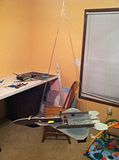In the past we've talked about the importance of balancing your airplane. You've heard us say that anything can fly as long as you have enough thrust, lift and BALANCE!
RC planes work like a fulcrum, a little weight in the tail equals a lot of weight in terms of CG (Center of Gravity). So the further back the weight is from the CG the more leverage it will create and the more unbalanced your RC plane will be. Flying even a slightly tail heavy plane will be much more difficult to fly compared to a nose heavy plane, and in today's Flite Tip we show the importance of balance, CG, and the effects of a tail heavy plane.
We put a bunch of weight in the tail of the plane to show the extreme effects of a tail heavy plane. Here's a few things to look for to know that your RC plane is tail heavy and needs to be balanced:
- The take-off will pitch up violently
- Pitch sensitive response
- Sensitive to any input
- The plane will want to porpoise around when trying to roll
In the video we also go over some basic maneuvers to help control your tail heavy plane and land it safely. One maneuver that can work with a tail heavy plane is to back off the throttle and put the plane into the wind. Remember that your pitch is going to be very sensitive, but as long as you're careful with your elevator you should be able to bring it in safely.
I hope this test helped show you the effects of an Aft CG plane and some tips to control and land it safely. Usually a properly balanced plane will give you the best performance in all aspects of flight.
Be sure to check out more great tips on our main site website!
Links mentioned in this episode:
How To Balance Your Plane
The Ventus
Retractable Landing Gear - Trojan T-28










